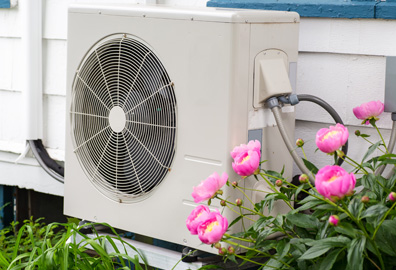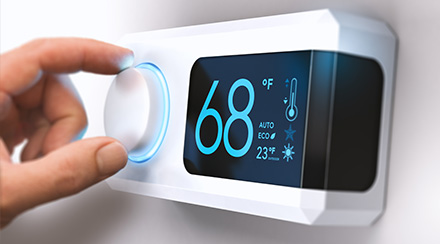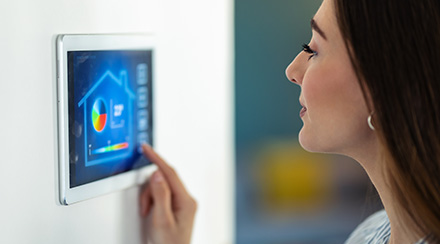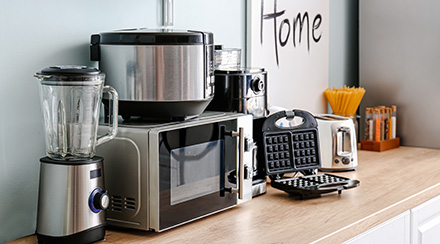What Are Heat Pumps and How Do They Work?

We use all sorts of different technologies to stay comfortable year-round. During hot weather, we use air conditioners, evaporative coolers and fans, just to name a few – and in cold weather, we use furnaces, boilers, radiators, stoves and other systems to keep warm. But one of the most modern climate control systems – the heat pump – can perform both heating and cooling, and it can do it more efficiently than many other systems.
What Are Heat Pumps?
Heat pumps are heating and cooling equipment that can replace both types of systems in most homes. There are a few different types of heat pumps, but what makes them different from other types of climate control systems is that they transfer and amplify heat rather than generate it. This difference makes heat pumps inherently more efficient than systems that generate heat, like gas or electric furnaces.
Types of Heat Pumps
There are some industrial-scale heat pumps that are designed to capture heat from manufacturing byproducts or waste, but when it comes to most homes and buildings, heat pumps generally fall into four categories:
- Air source heat pumps. These look similar to central air conditioning systems and use an air handler and duct network to distribute treated air. The heat pump, which is installed outdoors, pulls heat from the outdoor air in the winter and transfers it indoors. Even in freezing temperatures, modern heat pumps can effectively draw heat from the air. In summer, the process is reversed – the heat pump pulls heat out of the indoor air and expels it outdoors.
- Ductless air source heat pumps. These are heat pumps that resemble ductless mini-split air conditioners, but they are more energy efficient and capable of both heating and cooling. They’re ideal for treating the air in individual rooms that have exterior walls but no ductwork access.
- Ground source geothermal heat pumps. Ground source systems operate on the same principle of heat transfer as air source systems, but they pull heat from the ground instead of the air. In most systems, this is done with a coiled pipe that is buried underground. Refrigerant is circulated through the pipe, absorbing ground-based heat to transfer it to the indoor air in the winter, and absorbing indoor air heat to transfer it deep underground in the summer.
- Water source geothermal heat pumps. These systems are similar to ground source systems, but they pull heat from nearby sources of water. They can typically only be installed in structures that are adjacent to bodies of water like lakes, ponds or rivers.
How Do Heat Pumps Work?
Most heat pumps use a loop of refrigerant-filled coils to transfer heat, no matter what source they draw that heat from.
How does a heat pump work in winter? Liquid refrigerant is circulated through the outdoor portion of the coil loop, which may be exposed to air, ground or water. The liquid refrigerant absorbs heat from its source, which causes it to expand and turn into vapor. This vapor then flows to a compressor, which increases the temperature and pressure of the vapor before it flows to the indoor portion of the coil loop. This heat is transferred to the air handler, which blows warm air throughout the home. Meanwhile, the refrigerant turns back into a liquid as it cools and circulates back to the outdoor portion of the coil loop, where the process begins again.
How does a heat pump work in summer? The heat pump uses a reversing valve to reverse the flow of the refrigerant. In this mode, the liquid refrigerant absorbs heat from the coil loop inside the house. The refrigerant then flows to the outdoor portion of the loop, where the heat is released.
Energy Efficiency of Heat Pumps
Overall, heat pumps are more efficient than common systems like furnaces and air conditioners. That means you may be able to save big on heating and cooling costs over time if you make the switch. While it’s tricky to pinpoint exactly how much you could save, there are a few simple ways to compare the efficiency of a heat pump to your current system or other types of HVAC equipment:
SEER ratings. SEER stands for seasonal energy efficiency rating, and is a ratio of cooling output to electricity consumption. The higher the SEER rating, the more efficient the appliance is for cooling.
HSPF ratings. HSPF stands for heating seasonal performance factor, and it only applies to air source heat pumps. It’s a measurement of the unit’s heating efficiency, with higher HSPF ratings indicating better energy efficiency.
The EnergyGuide label. These black and yellow labels are required by federal law to be displayed on all new heat pumps, air conditioners, furnaces and boilers. They give estimates on annual energy consumption and operating costs, and they’re standardized to make it easy for shoppers to compare the efficiency of major appliances.
The ENERGY STAR symbol. The federal ENERGY STAR program was created to make it easier for consumers to identify energy efficient appliances. The presence of the ENERGY STAR logo alone won’t give you any data about the efficiency of a piece of equipment, but it allows you to see at a glance which models meet the highest efficiency benchmarks.
Heat Pump Pros and Cons
A heat pump can be a perfect fit for some homeowners, and more people are making the switch all the time. But heat pumps aren’t always right for every home and budget, so it’s important to consider all your circumstances and HVAC options before deciding that a heat pump is your best choice.
Heat Pump Pros
Heat pumps are energy efficient. As detailed above, a heat pump is often the most energy efficient HVAC option, delivering energy savings year after year.
Heat pumps are two systems in one. This can help simplify some big decisions about heating and cooling equipment, especially if you need a system with a small physical footprint.
Heat pumps are quiet. Compared to traditional central air conditioners and furnaces, heat pumps tend to make less noise.
Heat pumps are excellent dehumidifiers. Some heat pumps, especially ground source geothermal systems, dehumidify more efficiently than air conditioners.
Heat Pump Cons
Heat pumps are expensive. Equipment and installation costs vary, but the upfront costs of installing a heat pump are generally higher than those of installing central air and heating units. Air source heat pumps are the least expensive, while ground source geothermal systems can cost $20,000 or more depending on the complexity of the installation.
Heat pumps are less effective in very cold weather. Heat pumps used to be fairly exclusive to mild climates due to these limitations, but modern technology has enabled their use in colder climates. Still, because heating output can drop during extremely low temperatures, it’s helpful for homes in cold climates to have a supplemental heating system. You can still save energy overall with this setup, but it adds to the upfront installation costs.
Heat pumps “feel” different. Because they transfer heat rather than generate it, it’s hard to replicate the cozy feeling of sitting next to the vent during a heating cycle, which can be hard for some people to get used to. On the other hand, heat pumps heat more evenly, reducing hot spots and cold spots.
Is your home ready for an upgrade to heating and cooling with a heat pump? Before replacing your conventional furnace and air conditioner, take a look at heat pump technology to see how it compares.
Gas and electric dryers are both safe when they are installed, maintained and used properly. But they can malfunction dangerously in rare cases if they are used improperly or if there is a mechanical or electrical problem, and the safety risks differ by type.
Any appliance that runs on natural gas poses two safety concerns. First, natural gas can leak into a home due to improper installation, appliance malfunction or damage, which can cause natural gas poisoning or lead to a fire or explosion. Second, gas appliances produce carbon monoxide that can leak into a home due to improper or obstructed venting, causing illness or even death.
Gas dryers should always be installed, maintained and repaired by licensed repair professionals to minimize these risks. But because unseen damage can occur, there are two other precautions you should take. Be alert and take immediate action if you ever notice the telltale rotten egg smell coming from your laundry room – open windows if possible and evacuate the home, along with all other people and pets. Call your local gas utility to report the issue and follow their instructions. Also, install a carbon monoxide detector near your dryer and evacuate the home immediately if it alerts you to a leak. Don’t forget to test it regularly and replace the batteries every six months.
These concerns don’t apply to electric dryers, but both types of dryers can pose a small risk of electric shock due to faulty or damaged wiring. They can also both pose a small fire risk due to clogged lint filters, debris near the dryer and other types of improper use. It’s a good idea to read the safety instructions in your dryer’s manual and follow the manufacturer-specific recommendations.
Are Gas or Electric Dryers Better?
As you can see, there are a lot of factors to consider, and there’s no one-size-fits-all answer. In many cases, it may make sense to just stick with whatever type of dryer the home is already set up to accommodate. In other cases, local energy prices may justify a switch. And if you’re trying to reduce your home’s carbon footprint, making the switch from gas to electric can be part of the solution. But whatever you choose, maximize the efficiency and safety of your dryer by cleaning it regularly and following the manufacturer’s instructions.
Looking for ways to reduce your energy use? Read our article on energy-saving tips for more of our best methods to save energy in your home.
Looking for Something Specific?
Select a category to find resources for topics that interest you.
Select Category

Related Articles:

Tips for Improving Your AC and Furnace Efficiency
We share maintenance tips for your heater and AC, and home improvement tips to help you use those systems less.
Read Article
Tips for Saving on Energy in Your Home
If you’re looking to learn more about energy efficiency for home systems and appliances, we’re sharing our favorite energy-saving tips.
Read Article
What Uses the Most Electricity In a Home?
We break down what uses the most energy in your home to give you an understanding of where your energy usage goes and where energy-saving tactics can make the most impact.
Read ArticleMost Popular Articles

Energy Plans to Fit Your Lifestyle
NRG offers electricity and natural gas plans with perks like cash back, travel rewards and more, so you can find a plan that fits your home and family.
What Are Heat Pumps and How Do They Work?
We use all sorts of different technologies to stay comfortable year-round. During hot weather, we use air conditioners, evaporative coolers and fans, just to name a few – and in cold weather, we use furnaces, boilers, radiators, stoves and other systems to keep warm. But one of the most modern climate control systems – the heat pump – can perform both heating and cooling, and it can do it more efficiently than many other systems.
What Are Heat Pumps?
Heat pumps are heating and cooling equipment that can replace both types of systems in most homes. There are a few different types of heat pumps, but what makes them different from other types of climate control systems is that they transfer and amplify heat rather than generate it. This difference makes heat pumps inherently more efficient than systems that generate heat, like gas or electric furnaces.
Types of Heat Pumps
There are some industrial-scale heat pumps that are designed to capture heat from manufacturing byproducts or waste, but when it comes to most homes and buildings, heat pumps generally fall into four categories:
- Air source heat pumps. These look similar to central air conditioning systems and use an air handler and duct network to distribute treated air. The heat pump, which is installed outdoors, pulls heat from the outdoor air in the winter and transfers it indoors. Even in freezing temperatures, modern heat pumps can effectively draw heat from the air. In summer, the process is reversed – the heat pump pulls heat out of the indoor air and expels it outdoors.
- Ductless air source heat pumps. These are heat pumps that resemble ductless mini-split air conditioners, but they are more energy efficient and capable of both heating and cooling. They’re ideal for treating the air in individual rooms that have exterior walls but no ductwork access.
- Ground source geothermal heat pumps. Ground source systems operate on the same principle of heat transfer as air source systems, but they pull heat from the ground instead of the air. In most systems, this is done with a coiled pipe that is buried underground. Refrigerant is circulated through the pipe, absorbing ground-based heat to transfer it to the indoor air in the winter, and absorbing indoor air heat to transfer it deep underground in the summer.
- Water source geothermal heat pumps. These systems are similar to ground source systems, but they pull heat from nearby sources of water. They can typically only be installed in structures that are adjacent to bodies of water like lakes, ponds or rivers.
How Do Heat Pumps Work?
Most heat pumps use a loop of refrigerant-filled coils to transfer heat, no matter what source they draw that heat from.
How does a heat pump work in winter? Liquid refrigerant is circulated through the outdoor portion of the coil loop, which may be exposed to air, ground or water. The liquid refrigerant absorbs heat from its source, which causes it to expand and turn into vapor. This vapor then flows to a compressor, which increases the temperature and pressure of the vapor before it flows to the indoor portion of the coil loop. This heat is transferred to the air handler, which blows warm air throughout the home. Meanwhile, the refrigerant turns back into a liquid as it cools and circulates back to the outdoor portion of the coil loop, where the process begins again.
How does a heat pump work in summer? The heat pump uses a reversing valve to reverse the flow of the refrigerant. In this mode, the liquid refrigerant absorbs heat from the coil loop inside the house. The refrigerant then flows to the outdoor portion of the loop, where the heat is released.
Energy Efficiency of Heat Pumps
Overall, heat pumps are more efficient than common systems like furnaces and air conditioners. That means you may be able to save big on heating and cooling costs over time if you make the switch. While it’s tricky to pinpoint exactly how much you could save, there are a few simple ways to compare the efficiency of a heat pump to your current system or other types of HVAC equipment:
SEER ratings. SEER stands for seasonal energy efficiency rating, and is a ratio of cooling output to electricity consumption. The higher the SEER rating, the more efficient the appliance is for cooling.
HSPF ratings. HSPF stands for heating seasonal performance factor, and it only applies to air source heat pumps. It’s a measurement of the unit’s heating efficiency, with higher HSPF ratings indicating better energy efficiency.
The EnergyGuide label. These black and yellow labels are required by federal law to be displayed on all new heat pumps, air conditioners, furnaces and boilers. They give estimates on annual energy consumption and operating costs, and they’re standardized to make it easy for shoppers to compare the efficiency of major appliances.
The ENERGY STAR symbol. The federal ENERGY STAR program was created to make it easier for consumers to identify energy efficient appliances. The presence of the ENERGY STAR logo alone won’t give you any data about the efficiency of a piece of equipment, but it allows you to see at a glance which models meet the highest efficiency benchmarks.
Heat Pump Pros and Cons
A heat pump can be a perfect fit for some homeowners, and more people are making the switch all the time. But heat pumps aren’t always right for every home and budget, so it’s important to consider all your circumstances and HVAC options before deciding that a heat pump is your best choice.
Heat Pump Pros
Heat pumps are energy efficient. As detailed above, a heat pump is often the most energy efficient HVAC option, delivering energy savings year after year.
Heat pumps are two systems in one. This can help simplify some big decisions about heating and cooling equipment, especially if you need a system with a small physical footprint.
Heat pumps are quiet. Compared to traditional central air conditioners and furnaces, heat pumps tend to make less noise.
Heat pumps are excellent dehumidifiers. Some heat pumps, especially ground source geothermal systems, dehumidify more efficiently than air conditioners.
Heat Pump Cons
Heat pumps are expensive. Equipment and installation costs vary, but the upfront costs of installing a heat pump are generally higher than those of installing central air and heating units. Air source heat pumps are the least expensive, while ground source geothermal systems can cost $20,000 or more depending on the complexity of the installation.
Heat pumps are less effective in very cold weather. Heat pumps used to be fairly exclusive to mild climates due to these limitations, but modern technology has enabled their use in colder climates. Still, because heating output can drop during extremely low temperatures, it’s helpful for homes in cold climates to have a supplemental heating system. You can still save energy overall with this setup, but it adds to the upfront installation costs.
Heat pumps “feel” different. Because they transfer heat rather than generate it, it’s hard to replicate the cozy feeling of sitting next to the vent during a heating cycle, which can be hard for some people to get used to. On the other hand, heat pumps heat more evenly, reducing hot spots and cold spots.
Is your home ready for an upgrade to heating and cooling with a heat pump? Before replacing your conventional furnace and air conditioner, take a look at heat pump technology to see how it compares.
Gas and electric dryers are both safe when they are installed, maintained and used properly. But they can malfunction dangerously in rare cases if they are used improperly or if there is a mechanical or electrical problem, and the safety risks differ by type.
Any appliance that runs on natural gas poses two safety concerns. First, natural gas can leak into a home due to improper installation, appliance malfunction or damage, which can cause natural gas poisoning or lead to a fire or explosion. Second, gas appliances produce carbon monoxide that can leak into a home due to improper or obstructed venting, causing illness or even death.
Gas dryers should always be installed, maintained and repaired by licensed repair professionals to minimize these risks. But because unseen damage can occur, there are two other precautions you should take. Be alert and take immediate action if you ever notice the telltale rotten egg smell coming from your laundry room – open windows if possible and evacuate the home, along with all other people and pets. Call your local gas utility to report the issue and follow their instructions. Also, install a carbon monoxide detector near your dryer and evacuate the home immediately if it alerts you to a leak. Don’t forget to test it regularly and replace the batteries every six months.
These concerns don’t apply to electric dryers, but both types of dryers can pose a small risk of electric shock due to faulty or damaged wiring. They can also both pose a small fire risk due to clogged lint filters, debris near the dryer and other types of improper use. It’s a good idea to read the safety instructions in your dryer’s manual and follow the manufacturer-specific recommendations.
Are Gas or Electric Dryers Better?
As you can see, there are a lot of factors to consider, and there’s no one-size-fits-all answer. In many cases, it may make sense to just stick with whatever type of dryer the home is already set up to accommodate. In other cases, local energy prices may justify a switch. And if you’re trying to reduce your home’s carbon footprint, making the switch from gas to electric can be part of the solution. But whatever you choose, maximize the efficiency and safety of your dryer by cleaning it regularly and following the manufacturer’s instructions.
Looking for ways to reduce your energy use? Read our article on energy-saving tips for more of our best methods to save energy in your home.
Looking for Something Specific?
Select a category to find resources for topics that interest you.
Select Category

Related Articles:

Tips for Improving Your AC and Furnace Efficiency
We share maintenance tips for your heater and AC, and home improvement tips to help you use those systems less.
Read Article
Tips for Saving on Energy in Your Home
If you’re looking to learn more about energy efficiency for home systems and appliances, we’re sharing our favorite energy-saving tips.
Read Article
What Uses the Most Electricity In a Home?
We break down what uses the most energy in your home to give you an understanding of where your energy usage goes and where energy-saving tactics can make the most impact.
Read ArticleMost Popular Articles

Energy Plans to Fit Your Lifestyle
NRG offers electricity and natural gas plans with perks like cash back, travel rewards and more, so you can find a plan that fits your home and family.







